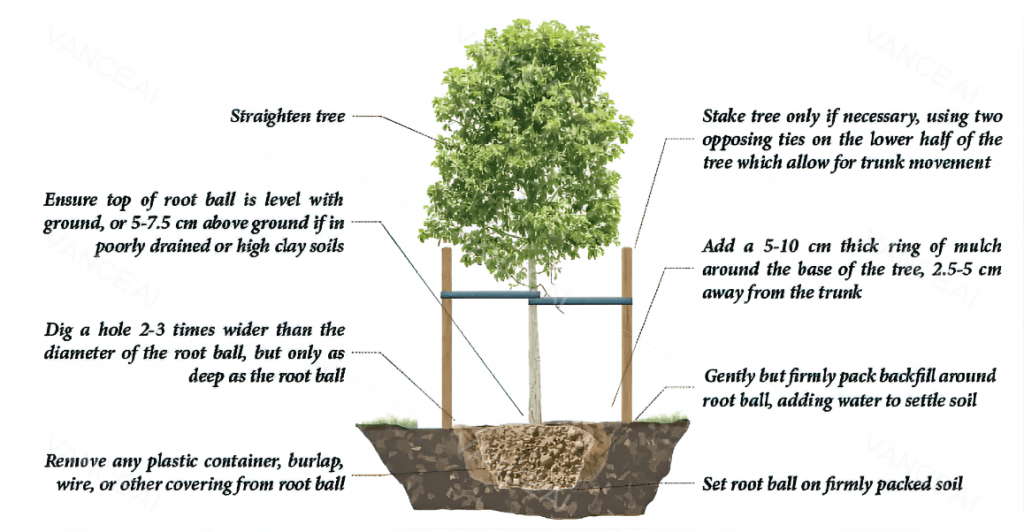Some tips for selecting, planting, and caring for trees.
This information is also available in a printable PDF: Town of Sidney Tree Planting Guide.
How much room do I have?
Trees come in all shapes and sizes and you should choose a planting location that will accommodate the growth of the tree both above and below ground.
Some important considerations include:
- Is there room for the tree canopy and roots to grow?
- Are there utilities overhead or underground?
- Where are my property lines?
- How will the tree growth impact my neighbours?
Prior to digging on your property contact BC 1 Call (1-800-474-6886) for information on underground utility locations. The Town can be contacted for information on property lines.
What are the site conditions?
The Saanich Peninsula is fortunate to have a mild climate and long growing season, however environmental conditions can still vary within individual properties, affecting tree growth. It is important to select a planting location that will be the best suited to the preferred growing conditions of your tree.
Some important considerations include:
- What are the light requirements of the tree?
- What are the soil moisture requirements of the tree?
- Is the soil shallow or deep? Soft or hard?
- Is the soil sandy, rich, or clay-based?
Thankfully, most trees purchased from local plant nurseries come with plant tags that detail the preferable growing requirements of the tree.
Selecting a tree to plant is exciting as there is a wide range of tree types and characteristics that you can choose from.
Some factors you may wish to consider include:
- Evergreen or deciduous?
- Tall, short, narrow or wide canopy?
- Native or non-native?
- Showy flowers or fall foliage?
- Fruit or nut bearing?
- Attracts wildlife?
- Privacy, or shelter from elements?
The Town encourages the planting of native tree species as they are best adapted to the local climate and provide the most benefits to the natural environment.
It can be helpful to consult with a local nursery to find the ideal tree for your chosen planting location.
When is the best time of year to plant a tree
Trees can be planted year-round given the proper care, however the best time of year to plant a tree is in the fall or early spring when the ground is thawed and moisture can reach the roots.
How do you plant a tree?
Planting a tree should be done with care to ensure it can become established quickly and grow healthily to maturity. Please see the graphic below detailing the necessary steps to plant a tree. It is a good idea to add some water to the hole after the tree has been placed inside, as well as during backfilling the whole to ensure the all roots receive moisture.
- Dig a hole 2-3 times wider than the diameter of the root ball, but only as deep as the root ball
- Remove any plastic container, burlap, wire, or other covering from the root ball
- Set root ball on firmly packed soil
- Straighten tree
- Gently but firmly pack backfill around root ball, adding water to settle soil
- Ensure top of root ball is level with ground, or 5-7.5 cm above ground if in poorly drained or high clay soils
- Add a 5-10 cm thick ring of mulch around the base of the tree, 2.5-5 cm away from the trunk
- Stake tree only if necessary, using two opposing ties on the lower half of the tree, which allow for trunk movement
Additional Tree Planting Resources
Additional tree planting guidance can be found in the following resources:
The first 1-3 years are the most critical for ensuring your tree is properly looked after. During this time it is important to watch for signs off stress, such as yellowing of the leaves, which can indicate that it may not be getting the care it needs.
Mulching
Mulch helps suppress weeds, provides nutrients for the tree, helps the soil retain moisture, and moderates soil temperature. Keep a 5-10 cm thick ring of mulch around the base of the tree, ensuring it is kept 2.5-5 cm away from the trunk.
Watering
Water your tree immediately after planting and at least once a week during summer months (May-September) to ensure the soil stays moist but is not waterlogged. Watering should be done slowly to ensure the water seeps deep into the ground around the trees roots, and does not get carried away along the surface of the soil.
Pruning
Pruning should be done carefully to allow for adequate branch spacing and to remove dead, damaged or rubbing branches. The best time of year to prune a tree is in the late fall or early spring when the tree is dormant.
Protection from wildlife
If deer or other browsers frequent your yard, it may be necessary to install fencing or netting around you tree to ensure it does not get damaged.
Additional Tree Care Resources
Additional tree planting guidance can be found in the following resource:
